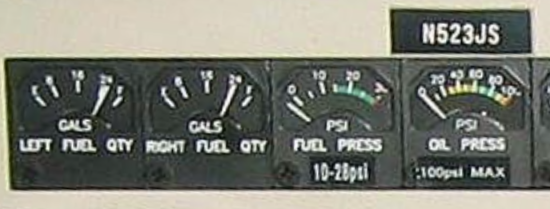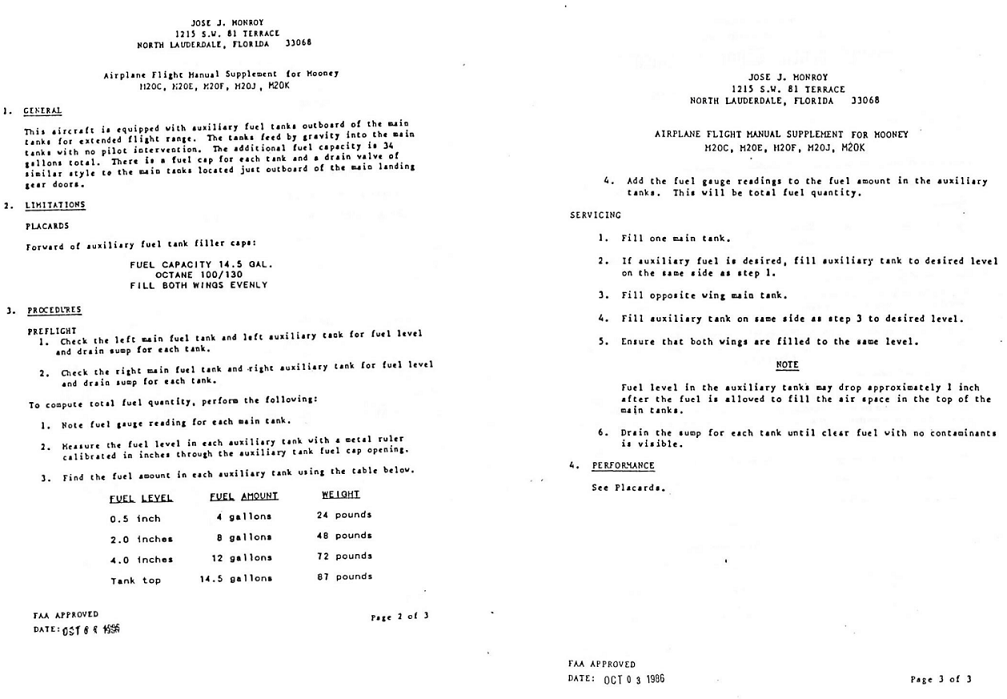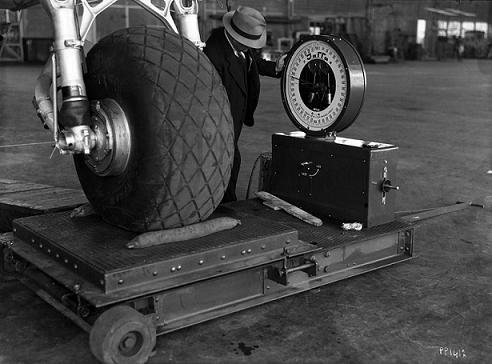
1980Mooney
Basic Member-
Posts
3,356 -
Joined
-
Last visited
-
Days Won
5
Content Type
Profiles
Forums
Blogs
Gallery
Downloads
Media Demo
Events
Everything posted by 1980Mooney
-
Was the June 2015 W&B also done by reweighing with cells or was it done by recomputing additions and removals?
-
The engine and prop combination used in the Rocket 305 (TSIO-520-N/NB & McCauley) are exactly the same as those used in the Cessna 340 & 414. RAM specializes in engines for Cessna twins so it is not surprising that they had one on the shelf that @Rocket 305 could use without delay.
-
Exactly right. You are right that the current factory senders hit their upper "Full" limit before you completely fill the Monroy auxiliary tanks. The Monroy tanks sit outboard on the dihedral wing and are slightly above the main tank. The Monroy auxiliary tank is connected to the Main tank with a single flow line with 6D fittings and a single vent line. I think that 6D line is about 3/8 inch ID. It flows between Main and Monroy Auxillary tanks by gravity. The point is that it flows slowly. If you fill only the Main tanks to the lip with 75.6 gallons (and none in the Monroys), the fuel does not rush into the Monroy tank. Your panel gauges will say "Full" at the moment after you fill the Mains. But if you wait 15 minutes or more the levels even out. The Main tank level drops and the Monroy will now have fuel in it rising by gravity to the same vertical level as the Main. Your panel gauges will then say about 3/4 or something like that (maybe 55-60 gallons). If you fill the Main to the lip and then the Monroy to the lip you will have your full 105 gallons. When you are flying and get down to about 1/2 tank as shown on your panel, then your panel fuel gauge will read accurately. The Monroys will have drained out completely into the Main. Only the Mains will have fuel and the factory sender will read correctly. So in the "current world", your current gauges read accurately between 1/2 and Zero. Your bottom half of your tank in each wign is 19 gallons. But the top half of your tank in each wing is 33 gallons. Your Monroy Supplement should have a conversion for you to stick measure the Monroy so you can determine how much is in each Monroy (while sitting level on the ground) whch you can add to what your panel is saying (reading only the Main). It is not perfect but you can rely upon your panle gauges when it matters - when fuel reads below 1/2 tank. As explained above it is not linear. This is similar with the Monroys in a J. There is a copy of the J Supplement.
-
In defense of the OP, he did state it, but just not where we expected. It was at the end of the last sentence in his original post. "( this is a 1984 MK20 231 - no low)" - and not in his profile. I was also originally confused. I drifted into this thread midstream and didn't read his post carefully. I was looking for it in his profile - but it was not there.
-
Me too. I use it all the time - works great for over 24 years without overhaul.
-
I suspect the fact that it is a Rocket Engineering conversion may have influenced the situation. Let's face it, if you are running a lean operation, have more calls and emails than you can answer, I can see that there would be less interest in working on a plane that is "foreign" from the firewall forward (perhaps no interest?). The Factory Service Center would have no drawings and few common parts from the Factory suppliers (certainly no matching factory part numbers) firewall forward for the Rocket 305 or Missile 300. The engines are different from the Acclaims and Ovations. The engine mounts are unique to Rocket Engineering and have nothing in common with Mooney Factory design. Cowlings are different, Etc. @DCarlton raises a good point - are there any PIREPs from owners of older short or mid bodies? Also what is the Factory appetite to work on all the other modified Mooneys? - Liquid Rocket, Turbo Bullet, M20-Turbos, Rayjay, and the defunct Mod Works, Mod Squad and Mooney Mart flavors of conversions that have no drawings or support - Trophy 262, Thunderbird 261, Trophy 211, Trophy 212, PFM/M20L Conversion, etc. as well as all the STC speed mods, gear doors, cowlings, from Mod Works, LASAR, Lo Presti etc, etc.? Also @Rocket 305 wanted to convert the ignition. All these bespoke modifications, with few exactly alike create a lot of extra work, many with poor or little documentation. The current crew at the Mooney Factory never had anything to do with and never turned a wrench building a short body or a mid body ( i.e. anything with a 4 cylinder Lycoming). I can understand if they prefer to work on unmodified Mooneys and especially Long bodies.
-
does your mechanic test fly your airplane after annual?
1980Mooney replied to rwabdu's topic in General Mooney Talk
Good advice. During the review of the disastrous Apollo 1 fire in 1967 that killed Grissom, White And Chaffee, the Command Module was disassembled. Inside the space capsule, which had been assembled in a clean room environment, a wrench socket was found. -
Anybody want to help me change a tire in Manassas?
1980Mooney replied to wombat's topic in General Mooney Talk
Hmmm...that sounds like it was an immigrant bird.... -
I had Monroy auxiliary tanks installed in my J more than 20 years ago. I have all the paperwork including the full installation manual and drawings. If you are looking in the Supplement for a conversion table for your panel gauges, there isn't any. The Supplement does have a table for you to manually stick measure the auxiliary tanks. The auxiliary tank drains into the main tank through a single line. The auxiliary tanks sit outboard and slightly higher than the main tank. Since you have speed brakes the Monroy auxiliary tanks hold only 14.5 gal. (vs. 17 gal. for those without speed brakes). When the main tank is half full the panel fuel gauge reads accurately. When it says "16" gallons on your plane then that is what you have. When it says "Full" then you have 46.5 gallons on that wing. So the first half spans 16 gallons and the last half spans 30.5 gallons. I don't think it is linear. I have 98 gallons total capacity. If I am at 98 (49 gal per side) or at 80 total (40 gal per side) the panel gauge reads about the same - i.e. "Full". The line between the auxiliary tank and the main tank has AN-6D fittings. I think that is 3/8 OD pipe and only about 0.3 inch ID. The point being that the gravity flow between the tanks is slow. If your main tanks are below 1/2 (16 gal) and you fill them full to the lip your panel fuel gauge will read full. Wait about 10 minutes and 8-10 gallons a side will flow into each auxiliary tank. Your panel fuel gauges will read about 2/3 to 3/4 full (24 gallons on your gauges). I use the Fuel Totalizer to keep tabs on the fuel when I am above 1/2 tank.. Between 1/2 and Full, the panel gauges just give me a rough idea of fuel on board. However I do know when my panel reads 1/2 full I know I have 16 gallons left in the tank. Here is the Supplement for your plane with speed brakes:
-
How many shop hours were quoted and how many were billed? @Alan Fox is estimating 60 hours.
-
@redbaron1982 has posted multiple times that he had Don Maxwell replace the right stub spar cap during 2022-23. Not sure if that is the same spar cap as you are contemplating. Based on the months he said it was at Maxwell’s and the price he has quoted here on MS, it was way, way more than 60 hours. Considering the angst he has posted on line several times, I suspect that he would share details with you.
-
Weight question came up today while weighing my plane
1980Mooney replied to hubcap's topic in General Mooney Talk
It will be white collar jobs in danger this time. No need for law firms to use jr. lawyers or interns to search through history of prior cases for precedent - financial analysts searching and analyzing trends, accountants - application of rules, tax - same, etc. The "safe" jobs of the future will be - food service jobs, caregiving, roofing, landscaping, sanitation, construction, and airplane mechanics! -
Weight question came up today while weighing my plane
1980Mooney replied to hubcap's topic in General Mooney Talk
Enjoy your time with them while you can. Your kids will grow up depending upon personalized ChatGTP bots and other AI to get all their information and answer all their questions - and probably use it to communicate with all their friends personalized AI Chatbots. Sifting through mountains of information in seconds is something that ChatGTP and other AI tools shine at even in their evolving forms today. Professionals in many areas have testimonials that tasks that used to be "a day and a half" online search are now done in minutes. New MIT Research Shows Spectacular Increase In White Collar Productivity From ChatGPT – JOSH BERSIN There will be no need to waste time in forums like this or reading blogs in order to sift out information. Let's face it that forums like this can consume way too much of one's time. There will be no more misunderstanding, incorrect assumptions, misreading, political rants, perceived negativity or BS. In fact kids will be even less likely to go their parents for questions and answers because their personal ChatGTP bot won't give them a lecture. And when your kids are in their teens, today's ChatGTP-4 will seem like a neanderthal clunker (like an iPhone3 today,...). They will have a hard time relating to your stories of the past: "When you were little, we used to use things called "Forums" for answers - like something called "Mooneyspace". But they died not long after AI Chatbots became popular and took over. Just like magazines and publications died when the "Forums" were popular. There are a few old fossils that pass around old copies of aging, yellowing paper publications/magazines like something called MAPA - which ceased long ago......" -
Weight question came up today while weighing my plane
1980Mooney replied to hubcap's topic in General Mooney Talk
@T. Peterson said: "This is my question: If your hangar floor had a six inch drop left to right or right to left, even though the whole airplane weighed the same as though level, would the low wheel weigh more than the high wheel? and "What if you did the same test with two scales, one under each foot. Do you think the total would add up accurately assuming the high scale would show less than the low scale?" In each case he is talking about one wheel or one scale which is at a "low" elevation (i.e. "lower") vs. the other wheel or one scale that is a "high" elevation (i.e. "higher). He is not referring to "tilt" of the scale or scales. And in the first case, if you are assuming that the entire floor is tilted and hence both scales are tilted, then both scales are equally in error percentagewise - He is asking if the wheel at the "low" (lower) elevation would weigh more than the wheel at the higher elevation. -
Weight question came up today while weighing my plane
1980Mooney replied to hubcap's topic in General Mooney Talk
The Tower of Pisa leans at 5.5 degrees. So you will have us imagine our plane is in a maintenance hangar that leans twice as much … Really? -
Weight question came up today while weighing my plane
1980Mooney replied to hubcap's topic in General Mooney Talk
In the 2,900 lb GW modification, Mooney only changed 2 tubulars less than 2 ft. long - from 0.035 to 0.049 wall thickness. part - 340155-135 (L&R). That can't make much change in weight. - less than 1 lb? -
Weight question came up today while weighing my plane
1980Mooney replied to hubcap's topic in General Mooney Talk
No - I just read it how it is written. -
Weight question came up today while weighing my plane
1980Mooney replied to hubcap's topic in General Mooney Talk
He didn’t say “tilted scale”. He just said “lower”. -
Weight question came up today while weighing my plane
1980Mooney replied to hubcap's topic in General Mooney Talk
Yes the low wheel would weigh more compared tho the weight when weighed absolutely level. And the high wheel would weigh less by an equal amount. -
Weight question came up today while weighing my plane
1980Mooney replied to hubcap's topic in General Mooney Talk
No you are missing his point - “ So not-only is the airplane not level, ”. He is saying it is a function of both the tilt of the plane and the tilt of the load cell It doesn’t matter if the plane is not level. It only matters if the load cell is tilted. You are missing my point which I thought was pretty clear. -
Weight question came up today while weighing my plane
1980Mooney replied to hubcap's topic in General Mooney Talk
I disagree with your comment about the plane. It does not matter if the plane is tilted. At the point it contacts the load cell the plane pushes down directly in the direction of the earths gravitational pull. It could be balancing on the edge of the wing tip. It will have no bearing on measuring the total weight. Only if the loadcell mechanism is tilted, and not directly perpendicular to the gravitational pull of the earth will it read in error. The error will be calculated by basic trigonometry. -
Weight question came up today while weighing my plane
1980Mooney replied to hubcap's topic in General Mooney Talk
I think what you are demonstrating is the if the load cell is not perpendicular to the earths gravitational pull it will measure the cosine of the weight. We are not talking about the load cell being unlevel - we are talking about the plane. For example the plane could have a load cell under each wheel. If the right main tire goes flat during 2 weighings it will still read the same total weight even though the right wing is now lower than the left side. In fact looking at the cosine table, your 7.4% error would correspond to about 22 degrees of angle. - that looks about like what you have done. -
Weight question came up today while weighing my plane
1980Mooney replied to hubcap's topic in General Mooney Talk
I think you are exactly right. I agree that you need to level the plane to drain the fuel tanks to the same point between different weighings in time to insure the same amount of "unusable fuel" on board. But if one does properly remove the usable fuel (leaving only "unusable"), at the moment the plane is weighed, the total weight of the plane will not change regardless if the plane is level or not. If one measures the weight simultaneously from 3 points, using accurate load cells, the total weight will be the same regardless of the level, laterally or longitudinally. A plane does not change in mass x the coefficient of gravity at that particular point on earth (i.e. "weight") regardless of if it is in a 15-degree climb, a 45-degree banked turn or completely nose down in a dive. Physics are physics and they don't lie. Perhaps the "level" talk is a vestige of the old days when they had to use a single massive mechanical scale which required jacking wheels up one at a time. -
Weight question came up today while weighing my plane
1980Mooney replied to hubcap's topic in General Mooney Talk
I think you mean that the individual scales are measuring right - they are accurately measuring the weight on the individual load cell - but if the plane is tilted at an angle, more weight at that particular moment will be on one side of the plane than the other. -
Weight question came up today while weighing my plane
1980Mooney replied to hubcap's topic in General Mooney Talk
I would think with the advances in today's digital load cells (with wireless connectivity, load cells on jack points, pads, etc,) that issues with accuracy are largely a non-issue today. I bet those "mysteriously gaining pounds" stories are more idle shop talk and denial by owners. It is like going to the doctor - telling them your weight on the appointment forms - then getting on the scale and acting surprised. "Gosh - I wonder where that weight came from..."








